Agricultural Eco-Efficiency: Challenges and Progress
Abstract
:1. Introduction
- (1)
- What is the general trend of AEE research?
- (2)
- What are the salient milestones and hot issues in AEE research?
- (3)
- What are the major areas of AEE research?
- (4)
- What are the challenges and future directions of AEE research?
2. Materials and Methods
3. Results
3.1. An Overview of AEE Research
3.2. Evolving Research Hot Topics
3.2.1. Analysis of Keywords and Hot Topics Distribution
- (1)
- Slow growth stage (1999–2010): This stage began to focus on agriculture, ecological efficiency, and life-cycle review. The concept of ecological efficiency was firstly put forward by Schaltegger, a famous German scholar, in the early 1990s [14]. In the following decade, academies completed multifaceted and in-depth research around the concept.
- (2)
- Fluctuant rising stage (2010–2016): At this stage, research on environmental performance, agricultural sustainability, and greenhouse gas emissions gradually attracted attention. With the rapid development of agriculture, agricultural pollution became increasingly serious. The research focused on how to improve agricultural output and reduce agricultural production pollution to promote agricultural ecological improvement, which is an important issue for agricultural sustainable development.
- (3)
- Rapid development stage (2016–2021): Against the background of the accelerating process of new industrialization, the improvement of agricultural productivity brought more and more serious problems of environmental pollution and resource waste, which will directly and seriously affect the long-term development of agriculture. Experts and scholars have done research on AEE from different angles and levels, including technical efficiency, land use, wastewater reuse, industrial ecology, common agricultural policy, carbon emission, and other details related to agricultural eco-efficiency.
3.2.2. Burst Words Analysis
3.2.3. Analysis of Institutional Cooperation Network
4. Key Fields and Hot Topics of AEE Research
4.1. Theories and Hypothesis of AEE
4.2. Evaluation Methods of AEE
4.2.1. Ratio Analysis
4.2.2. Life Cycle Assessment (LCA)
4.2.3. Ecological Footprint Analysis
4.2.4. Stochastic Frontier Analysis (SFA)
4.2.5. Emergy Analysis (EMA)
4.2.6. Data Envelopment Analysis (DEA)
4.3. The Impacts of AEE on “Social-Economic-Ecological” System
4.3.1. Impacts of AEE on Social Development
4.3.2. Impacts of AEE on Economic Growth
4.3.3. Impacts of AEE on Ecosystem Services
4.4. Drivers and Regulation of AEE
4.4.1. Research on the Driving Factors of AEE
4.4.2. Research on Optimal Regulation of AEE
5. Discussion
5.1. AEE Research from the Perspective of Low Carbon
5.2. The Impact of Farmland Ownership Confirmation Reform on AEE
5.3. AEE Temporal and Spatial Characteristics and Influencing Factors
6. Conclusions
Author Contributions
Funding
Institutional Review Board Statement
Informed Consent Statement
Conflicts of Interest
References
- Guo, B.; He, D.; Zhao, X.; Zhang, Z.; Dong, Y. Analysis on the Spatiotemporal Patterns and Driving Mechanisms of China’s Agricultural Production Efficiency from 2000 to 2015. Phys. Chem. Earth 2020, 120, 102909. [Google Scholar] [CrossRef]
- Liu, Y.; Zou, L.; Wang, Y. Spatial-Temporal Characteristics and Influencing Factors of Agricultural Eco-Efficiency in China in Recent 40 Years. Land Use Policy 2020, 97, 104794. [Google Scholar] [CrossRef]
- Pang, J.; Chen, X.; Zhang, Z.; Li, H. Measuring Eco-Efficiency of Agriculture in China. Sustainability 2016, 8, 398. [Google Scholar] [CrossRef] [Green Version]
- Golas, M.; Sulewski, P.; Was, A.; Kloczko-Gajewska, A.; Pogodzinska, K. On the Way to Sustainable Agriculture-Eco-Efficiency of Polish Commercial Farms. Agriculture 2020, 10, 438. [Google Scholar] [CrossRef]
- Grzelak, A.; Staniszewski, J.; Borychowski, M. Income or Assets-What Determines the Approach to the Environment among Farmers in A Region in Poland? Sustainability 2020, 12, 4917. [Google Scholar] [CrossRef]
- Yanlin, X.; Zijun, L.; Liang, W. Temporal Spatial Differences in and Influencing Factors of Agricultural Eco-Efficiency in Shandong Province, China. Cienc. Rural 2020, 50, e20190818. [Google Scholar] [CrossRef]
- Wang, Y.; Zhao, G. Life Cycle Assessment of Potential Pollutant-Induced Human Capital Loss Caused by Different Agricultural Production Systems in Beijing, China. J. Clean. Prod. 2019, 240, 118141. [Google Scholar] [CrossRef]
- Deng, X.; Gibson, J. Improving Eco-Efficiency for the Sustainable Agricultural Production: A Case Study in Shandong, China. Technol. Forecast. Soc. Chang. 2019, 144, 394–400. [Google Scholar] [CrossRef]
- Coluccia, B.; Valente, D.; Fusco, G.; De Leo, F.; Porrini, D. Assessing agricultural eco-efficiency in Italian Regions. Ecol. Indic. 2020, 116, 106483. [Google Scholar] [CrossRef]
- Liu, W. The Data Source of This Study Is Web of Science Core Collection? Not Enough. Scientometrics 2019, 121, 1815–1824. [Google Scholar] [CrossRef]
- Cui, Y.; Mou, J.; Liu, Y. Knowledge Mapping of Social Commerce Research: A Visual Analysis Using Cite Space. Electron. Commer. Res. 2018, 18, 837–868. [Google Scholar] [CrossRef]
- Ding, X.; Yang, Z. Knowledge Mapping of Platform Research: A Visual Analysis Using VOSviewer and CiteSpace. Electron. Commer. Res. 2020. [Google Scholar] [CrossRef]
- Hu, W.; Li, C.; Ye, C.; Wang, J.; Wei, W.; Deng, Y. Research Progress on Ecological Models in the Field of Water Eutrophication: CiteSpace Analysis Based on Data from the ISI Web of Science Database. Ecol. Model. 2019, 410, 108779. [Google Scholar] [CrossRef]
- Kicherer, A.; Schaltegger, S.; Tschochohei, H.; Pozo, B. Eco-Efficiency. Int. J. LCA 2007, 12, 537–543. [Google Scholar] [CrossRef]
- Fang, Y. Visualizing the Structure and the Evolving of Digital Medicine: A Scientometrics Review. Scientometrics 2015, 105, 5–21. [Google Scholar] [CrossRef]
- Lundahl, M. ‘Efficient but Poor’, —Schultz’, Theory of Traditional Agriculture. Scand. Econ. Hist. Rev. 1987, 35, 108–129. [Google Scholar] [CrossRef]
- Hu, Z. Green Taxation and Total Factor Productivity. Mod. Econ. 2019, 10, 698–706. [Google Scholar] [CrossRef] [Green Version]
- Zeng, L.; Li, X.; Ruiz-Menjivar, J. The Effect of Crop Diversity on Agricultural Eco-Efficiency in China: A Blessing or a Curse? J. Clean. Prod. 2020, 276, 124243. [Google Scholar] [CrossRef]
- Yang, B.; Wang, Z.; Zou, L.; Zou, L.; Zhang, H. Exploring the Eco-Efficiency of Cultivated Land Utilization and Its Influencing Factors in China’s Yangtze River Economic Belt, 2001–2018. J. Environ. Manag. 2021, 294, 112939. [Google Scholar] [CrossRef] [PubMed]
- Yin, K.; Wang, R.; Zhou, C.; Liang, J. Review of Eco-Efficiency Accounting Method and Its Applications. Acta Ecol. Sin. 2012, 32, 3595–3605. [Google Scholar] [CrossRef]
- Xiang, H.; Wang, Y.H.; Huang, Q.Q.; Yang, Q.Y. How Much Is the Eco-Efficiency of Agricultural Production in West China? Evidence from the Village Level Data. Int. J. Environ. Res. Public Health 2020, 17, 4049. [Google Scholar] [CrossRef] [PubMed]
- Wang, Y.; Shen, N. Agricultural Environmental Efficiency and Agricultural Environmental Kuznets Curve Based on Technological Gap: The Case of China. Pol. J. Environ. Stud. 2016, 25, 1293–1303. [Google Scholar] [CrossRef]
- Konefal, J.; Hatanaka, M.; Constance, D.H. Multi-Stakeholder Initiatives and the Divergent Construction and Implementation of Sustainable Agriculture in the USA. Renew. Agric. Food Syst. 2019, 34, 293–303. [Google Scholar] [CrossRef]
- Reith, C.C.; Guidry, M.J. Eco-Efficiency Analysis of an Agricultural Research Complex. J. Environ. Manag. 2003, 68, 219–229. [Google Scholar] [CrossRef]
- Georgopoulou, A.; Angelis-Dimakis, A.; Arampatzis, G.; Assimacopoulos, D. Improving the Eco-Efficiency of an Agricultural Water Use System. Desalination Water Treat. 2016, 57, 11484–11493. [Google Scholar] [CrossRef] [Green Version]
- Czyzewski, B.; Guth, M. Impact of Policy and Factor Intensity on Sustainable Value of European Agriculture: Exploring Trade-Offs of Environmental, Economic and Social Efficiency at the Regional Level. Agriculture 2021, 11, 78. [Google Scholar] [CrossRef]
- Costa, M.P.; Schoeneboom, J.C.; Oliveira, S.A.; Vinas, R.S.; de Medeiros, G.A. A Socio-Eco-Efficiency Analysis of Integrated and Non-Integrated Crop-Livestock-Forestry Systems in the Brazilian Cerrado Based on LCA. J. Clean. Prod. 2018, 171, 1460–1471. [Google Scholar] [CrossRef] [Green Version]
- Baum, R.; Bienkowski, J. Eco-Efficiency in Measuring the Sustainable Production of Agricultural Crops. Sustainability 2020, 12, 1418. [Google Scholar] [CrossRef] [Green Version]
- Lijo, L.; Lorenzo-Toja, Y.; Gonzalez-Garcia, S.; Bacenetti, J.; Negri, M.; Teresa Moreira, M. Eco-Efficiency Assessment of Farm-Scaled Biogas Plants. Bioresour. Technol. 2017, 237, 146–155. [Google Scholar] [CrossRef]
- Canaj, K.; Mehmeti, A.; Morrone, D.; Toma, P.; Todorovi, M. Life Cycle-Based Evaluation of Environmental Impacts and External Costs of Treated Wastewater Reuse for Irrigation: A Case Study in Southern Italy. J. Clean. Prod. 2021, 293, 126142. [Google Scholar] [CrossRef]
- Saling, P. Assessing Industrial Biotechnology Products with LCA and Eco-Efficiency. In Sustainability and Life Cycle Assessment in Industrial Biotechnology; Frohling, M., Hiete, M., Eds.; Springer International Publishing: Cham, Switzerland, 2020; Volume 173, pp. 325–357. ISBN 978-3-030-47066-1. [Google Scholar]
- Wackernagel, M.; Galli, A. An Overview on Ecological Footprint and Sustainable Development: A Chat with Mathis Wackernagel. Int. J. Ecodynamics 2007, 2, 1–9. [Google Scholar] [CrossRef]
- Brizga, J.; Miceikiene, A.; Liobikiene, G. Environmental Aspects of the Implementation of Bioeconomy in the Baltic Sea Region: An Input-Output Approach. J. Clean. Prod. 2019, 240, 118238. [Google Scholar] [CrossRef]
- Jia, F.; Hubbard, M.; Zhang, T.; Chen, L. Water Stewardship in Agricultural Supply Chains. J. Clean. Prod. 2019, 235, 1170–1188. [Google Scholar] [CrossRef]
- Rudinskaya, T.; Naglova, Z. Analysis of Consumption of Nitrogen Fertilisers and Environmental Efficiency in Crop Production of EU Countries. Sustainability 2021, 13, 8720. [Google Scholar] [CrossRef]
- Moutinho, V.; Madaleno, M.; Macedo, P.; Robaina, M.; Marques, C. Efficiency in the European Agricultural Sector: Environment and Resources. Environ. Sci. Pollut. Res. 2018, 25, 17927–17941. [Google Scholar] [CrossRef]
- Coelli, T. Recent Development in Frontier Modelling and Efficiency Measurement. Aust. J. Agric. Resour. Econ. 2012, 39, 219–245. [Google Scholar] [CrossRef] [Green Version]
- Orea, L.; Wall, A. A Parametric Approach to Estimating Eco-Efficiency. J. Agric. Econ. 2017, 68, 901–907. [Google Scholar] [CrossRef]
- Moutinho, V.; Robaina, M.; Macedo, P. Economic-Environmental Efficiency of European Agriculture—A Generalized Maximum Entropy Approach. Agric. Econ.-Zemed. Ekon. 2018, 64, 423–435. [Google Scholar] [CrossRef] [Green Version]
- Wang, Y.; Zhao, G. A Joint Use of Life Cycle Assessment and Emergy Analysis for Sustainability Evaluation of an Intensive Agro-System in China. Environ. Dev. Sustain. 2021. [Google Scholar] [CrossRef]
- Zeng, X.; Lu, H.; Campbell, D.E.; Ren, H. Integrated Emergy and Economic Evaluation of Tea Production Chains in Anxi, China. Ecol. Eng. 2013, 60, 354–362. [Google Scholar] [CrossRef]
- Bastianoni, S.; Marchettini, N.; Panzieri, M.; Tiezzi, E. Sustainability Assessment of a Farm in the Chianti Area (Italy). J. Clean. Prod. 2001, 9, 365–373. [Google Scholar] [CrossRef]
- Wang, Y.; Lin, C.; Li, J.; Duan, N.; Li, X.; Fu, Y. Emergy Analysis of Biogas Systems Based on Different Raw Materials. Sci. World J. 2013, 2013, 415812. [Google Scholar] [CrossRef] [Green Version]
- Charnes, A.; Cooper, W.W.; Rhodes, E. Measuring the Efficiency of Decision Making Units—ScienceDirect. Eur. J. Oper. Res. 1978, 2, 429–444. [Google Scholar] [CrossRef]
- Chen, X.; Liu, X.; Gong, Z.; Xie, J. Three-Stage Super-Efficiency DEA Models Based on the Cooperative Game and Its Application on the R&D Green Innovation of the Chinese High-Tech Industry. Comput. Ind. Eng. 2021, 156, 107234. [Google Scholar] [CrossRef]
- Angulo-Meza, L.; Gonzalez-Araya, M.; Iriarte, A.; Rebolledo-Leiva, R.; Carlos Soares de Mello, J. A Multiobjective DEA Model to Assess the Eco-Efficiency of Agricultural Practices within the CF plus DEA Method. Comput. Electron. Agric. 2019, 161, 151–161. [Google Scholar] [CrossRef]
- Wu, H.; Du, S.; Liang, L.; Zhou, Y. A DEA-Based Approach for Fair Reduction and Reallocation of Emission Permits. Math. Comput. Model. 2013, 58, 1095–1101. [Google Scholar] [CrossRef]
- Vlontzos, G.; Pardalos, P.M. Assess and Prognosticate Green House Gas Emissions from Agricultural Production of EU Countries, by Implementing, DEA Window Analysis and Artificial Neural Networks. Renew. Sustain. Energy Rev. 2017, 76, 155–162. [Google Scholar] [CrossRef]
- Tone, K.; Tsutsui, M. Network DEA: A Slacks-Based Measure Approach. Eur. J. Oper. Res. 2009, 197, 243–252. [Google Scholar] [CrossRef] [Green Version]
- Han, H.; Zhong, Z.; Wen, C.; Sun, H. Agricultural Environmental Total Factor Productivity in China under Technological Heterogeneity: Characteristics and Determinants. Environ. Sci. Pollut. Res. 2018, 25, 32096–32111. [Google Scholar] [CrossRef]
- Liang, L.; Lal, R.; Ridoutt, B.G.; Zhao, G.; Du, Z.; Li, L.; Feng, D.; Wang, L.; Peng, P.; Hang, S.; et al. Multi-Indicator Assessment of a Water-Saving Agricultural Engineering Project in North Beijing, China. Agric. Water Manag. 2018, 200, 34–46. [Google Scholar] [CrossRef]
- Li, Z.; Sarwar, S.; Jin, T. Spatiotemporal Evolution and Improvement Potential of Agricultural Eco-Efficiency in Jiangsu Province. Front. Energy Res. 2021, 9, 2021040431. [Google Scholar] [CrossRef]
- Maia, R.; Silva, C.; Costa, E. Eco-Efficiency Assessment in the Agricultural Sector: The Monte Novo Irrigation Perimeter, Portugal. J. Clean. Prod. 2016, 138, 217–228. [Google Scholar] [CrossRef] [Green Version]
- Mellon-Bedi, S.; Descheemaeker, K.; Hundie-Kotu, B.; Frimpong, S.; Groot, J.C.J. Motivational Factors Influencing Farming Practices in Northern Ghana. Njas-Wagening. J. Life Sci. 2020, 92, 100326. [Google Scholar] [CrossRef]
- Wang, L.Y.; Xiao, Y.; Rao, E.M.; Jiang, L.; Xiao, Y.; Ouyang, Z.-Y. An Assessment of the Impact of Urbanization on Soil Erosion in Inner Mongolia. Int. J. Environ. Res. Public Health 2018, 15, 550. [Google Scholar] [CrossRef] [PubMed] [Green Version]
- Wang, H.; Zhuo, Y. The Necessary Way for the Development of China’s Rural Areas in the New Era-Rural Revitalization Strategy. Open J. Soc. Sci. 2018, 6, 97–106. [Google Scholar] [CrossRef] [Green Version]
- Zhao, L.; Jing, R.; Yu, G. Research on the Implementation Path of Rural Revitalization Strategy Based on Computer Big Data and Industrial Revitalization. J. Phys. Conf. Ser. 2020, 1648, 022165. [Google Scholar] [CrossRef]
- Balezentis, T.; Ribasauskiene, E.; Morkunas, M.; Volkov, A.; Streimikiene, D.; Toma, P. Young Farmers’ Support under the Common Agricultural Policy and Sustainability of Rural Regions: Evidence from Lithuania. Land Use Policy 2020, 94, 104542. [Google Scholar] [CrossRef]
- Reheul, D.; Cougnon, M.; Kayser, M.; Pannecoucque, J.; Swanckaert, J.; De Cauwer, B.; van den Pol-van Dasselaar, A.; De Vliegher, A. Sustainable Intensification in the Production of Grass and Forage Crops in the Low Countries of North-West Europe. Grass Forage Sci. 2017, 72, 369–381. [Google Scholar] [CrossRef]
- Gava, O.; Bartolini, F.; Venturi, F.; Brunori, G.; Pardossi, A. Improving Policy Evidence Base for Agricultural Sustainability and Food Security: A Content Analysis of Life Cycle Assessment Research. Sustainability 2020, 12, 1033. [Google Scholar] [CrossRef] [Green Version]
- Zhou, X.; Xue, Z.; Seydehmet, J. An Empirical Study on Industrial Eco-Efficiency in Arid Resource Exploitation Region of Northwest China. Environ. Sci. Pollut. Res. 2021, 28, 53394–53411. [Google Scholar] [CrossRef]
- Emec, S.; Bilge, P.; Seliger, G. Design of Production Systems with Hybrid Energy and Water Generation for Sustainable Value Creation. Clean Technol. Environ. Policy 2015, 17, 1807–1829. [Google Scholar] [CrossRef] [Green Version]
- Medeiros, G.; Florindo, T.; Talamini, E.; Fett Neto, A.; Ruviaro, C. Optimising Tree Plantation Land Use in Brazil by Analysing Trade-Offs between Economic and Environmental Factors Using Multi-Objective Programming. Forests 2020, 11, 723. [Google Scholar] [CrossRef]
- Mu, W.; Kanellopoulos, A.; van Middelaar, C.E.; Stilmant, D.; Bloemhof, J.M. Assessing the Impact of Uncertainty on Benchmarking the Eco-Efficiency of Dairy Farming Using Fuzzy Data Envelopment Analysis. J. Clean. Prod. 2018, 189, 709–717. [Google Scholar] [CrossRef]
- Zhao, R.; Liu, Y.; Zhang, Z.; Guo, S.; Tseng, M.-L.; Wu, K.-J. Enhancing Eco-Efficiency of Agro-Products’ Closed-Loop Supply Chain under the Belt and Road Initiatives: A System Dynamics Approach. Sustainability 2018, 10, 668. [Google Scholar] [CrossRef] [Green Version]
- Borychowski, M.; Stepien, S.; Polcyn, J.; Tosovic-Stevanovic, A.; Calovic, D.; Lalic, G.; Zuza, M. Socio-Economic Determinants of Small Family Farms’ Resilience in Selected Central and Eastern European Countries. Sustainability 2020, 12, 10362. [Google Scholar] [CrossRef]
- Coderoni, S.; Esposti, R. CAP Payments and Agricultural GHG Emissions in Italy. A Farm-Level Assessment. Sci. Total Environ. 2018, 627, 427–437. [Google Scholar] [CrossRef]
- He, G.; Cui, Z.; Ying, H.; Zheng, H.; Wang, Z.; Zhang, F. Managing the Trade-Offs among Yield Increase, Water Resources Inputs and Greenhouse Gas Emissions in Irrigated Wheat Production Systems. J. Clean. Prod. 2017, 164, 567–574. [Google Scholar] [CrossRef]
- Fei, R.L.; You, W.H.; Wang, H.L. Can China Achieve Its CO2 Emission Reduction Targets in Agriculture Sector? Evidence from Technological Efficiency Analysis. Int. J. Environ. Sci. Technol. 2020, 17, 4249–4264. [Google Scholar] [CrossRef]
- Rao, I.; Peters, M.; Castro, A.; Schultze-Kraft, R.; White, D.; Fisher, M.; Miles, J.; Lascano, C.; Bluemmel, M.; Bungenstab, D.; et al. LivestockPlus—The Sustainable Intensification of Forage-Based Agricultural Systems to Improve Livelihoods and Ecosystem Services in the Tropics. Trop. Grassl.-Forrajes Trop. 2015, 3, 59–82. [Google Scholar] [CrossRef]
- Kyrgiakos, L.S.; Vlontzos, G.; Pardalos, P.M. Ranking EU Agricultural Sectors under the Prism of Alternative Widths on Window DEA. Energies 2021, 14, 1021. [Google Scholar] [CrossRef]
- Hamedani, S.R.; Del Zotto, L.; Bocci, E.; Colantoni, A.; Villarini, M. Eco-Efficiency Assessment of Bioelectricity Production from Iranian Vineyard Biomass Gasification. Biomass Bioenergy 2019, 127, 105271. [Google Scholar] [CrossRef]
- Liao, J.; Yu, C.; Feng, Z.; Zhao, H.; Wu, K.; Ma, X. Spatial Differentiation Characteristics and Driving Factors of Agricultural Eco-Efficiency in Chinese Provinces from the Perspective of Ecosystem Services. J. Clean. Prod. 2021, 288, 125466. [Google Scholar] [CrossRef]
- You, H.; Zhang, X. Ecoefficiency of Intensive Agricultural Production and Its Influencing Factors in China: An Application of DEA-Tobit Analysis. Discrete Dyn. Nat. Soc. 2016, 2016, 4786090. [Google Scholar] [CrossRef]
- Fridrihsone, A.; Romagnoli, F.; Cabulis, U. Environmental Life Cycle Assessment of Rapeseed and Rapeseed Oil Produced in Northern Europe: A Latvian Case Study. Sustainability 2020, 12, 5699. [Google Scholar] [CrossRef]
- Balezentis, T.; Li, T.; Streimikiene, D.; Balezentis, A. Is the Lithuanian Economy Approaching the Goals of Sustainable Energy and Climate Change Mitigation? Evidence from DEA-Based Environmental Performance Index. J. Clean. Prod. 2016, 116, 23–31. [Google Scholar] [CrossRef]
- Paramesh, V.; Arunachalam, V.; Nikkhah, A.; Das, B.; Ghnimi, S. Optimization of Energy Consumption and Environmental Impacts of Arecanut Production through Coupled Data Envelopment Analysis and Life Cycle Assessment. J. Clean. Prod. 2018, 203, 674–684. [Google Scholar] [CrossRef]
- Mehmeti, A.; Todorovic, M.; Scardigno, A. Assessing the Eco-Efficiency Improvements of Sinistra Ofanto Irrigation Scheme. J. Clean. Prod. 2016, 138, 208–216. [Google Scholar] [CrossRef]
- Magarey, R.D.; Klammer, S.S.H.; Chappell, T.M.; Trexler, C.M.; Pallipparambil, G.R.; Hain, E.F. Eco-Efficiency as a Strategy for Optimizing the Sustainability of Pest Management. Pest Manag. Sci. 2019, 75, 3129–3134. [Google Scholar] [CrossRef]
- Han, H.; Ding, T.; Nie, L.; Hao, Z. Agricultural Eco-Efficiency Loss under Technology Heterogeneity given Regional Differences in China. J. Clean. Prod. 2020, 250, 119511. [Google Scholar] [CrossRef]
- Eder, A.; Salhofer, K.; Scheichel, E. Land Tenure, Soil Conservation, and Farm Performance: An Eco-Efficiency Analysis of Austrian Crop Farms. Ecol. Econ. 2021, 180, 106861. [Google Scholar] [CrossRef]
- Czyzewski, B.; Matuszczak, A.; Grzelak, A.; Guth, M.; Majchrzak, A. Environmental Sustainable Value in Agriculture Revisited: How Does Common Agricultural Policy Contribute to Eco-Efficiency? Sustain. Sci. 2021, 16, 137–152. [Google Scholar] [CrossRef]
- Bai, H.; Tao, F. Sustainable Intensification Options to Improve Yield Potential and Ecoefficiency for Rice-Wheat Rotation System in China. Field Crops Res. 2017, 211, 89–105. [Google Scholar] [CrossRef]
- Jirapornvaree, I.; Suppadit, T.; Kumar, V. Assessing the Environmental Impacts of Agrifood Production. Clean Technol. Environ. Policy 2021. [Google Scholar] [CrossRef] [PubMed]
- Bharath, K.N.; Basavarajappa, S. Applications of Biocomposite Materials Based on Natural Fibers from Renewable Resources: A Review. Sci. Eng. Compos. Mater. 2016, 23, 123–133. [Google Scholar] [CrossRef]
- Heidari, M.D.; Turner, I.; Ardestani-Jaafari, A.; Pelletier, N. Operations Research for Environmental Assessment of Crop-Livestock Production Systems. Agric. Syst. 2021, 193, 103208. [Google Scholar] [CrossRef]
- Zou, Z.; Zeng, F.; Wang, K.; Zeng, Z.; Zhao, L.; Du, H.; Zhang, F.; Zhang, H. Emergy and Economic Evaluation of Seven Typical Agroforestry Planting Patterns in the Karst Region of Southwest China. Forests 2019, 10, 138. [Google Scholar] [CrossRef] [Green Version]
- Matuszczak, A.; Kryszak, L.; Czyzewski, B.; Lopatka, A. Environment and Political Economics: Left-Wing Liberalism or Conservative Leftism—Which Is Better for Eco-Efficiency? Evidence from Poland. Sci. Total Environ. 2020, 743, 140779. [Google Scholar] [CrossRef] [PubMed]
- Prestegard, S. Multifunctional Agriculture, Policy Measures and the WTO: The Norwegian Case. Food Econ.-Acta Agric. Scand. Sect. C 2004, 1, 151–162. [Google Scholar] [CrossRef]
- Zeng, S.X.; Meng, X.H.; Yin, H.T.; Tam, C.M.; Sun, L. Impact of Cleaner Production on Business Performance. J. Clean. Prod. 2010, 18, 975–983. [Google Scholar] [CrossRef]
- Khoshroo, A.; Izadikhah, M.; Emrouznejad, A. Improving Energy Efficiency Considering Reduction of CO2 Emission of Turnip Production: A Novel Data Envelopment Analysis Model with Undesirable Output Approach. J. Clean. Prod. 2018, 187, 605–615. [Google Scholar] [CrossRef] [Green Version]
- Heidenreich, A.; Grovermann, C.; Kadzere, I.; Egyir, I.S.; Muriuki, A.; Bandanaa, J.; Clottey, J.; Ndungu, J.; Blockeel, J.; Muller, A.; et al. Sustainable Intensification Pathways in Sub-Saharan Africa: Assessing Eco-Efficiency of Smallholder Perennial Cash Crop Production. Agric. Syst. 2022, 195, 103304. [Google Scholar] [CrossRef]
- Chen, R.; Zhang, R.; Han, H.; Jiang, Z. Is Farmers’ Agricultural Production a Carbon Sink or Source?—Variable System Boundary and Household Survey Data. J. Clean. Prod. 2020, 266, 122108. [Google Scholar] [CrossRef]
- Zhao, X.; Zhang, X.; Li, N.; Shao, S.; Geng, Y. Decoupling Economic Growth from Carbon Dioxide Emissions in China: A Sectoral Factor Decomposition Analysis. J. Clean. Prod. 2017, 142, 3500–3516. [Google Scholar] [CrossRef]
- Holka, M. Assessment of Carbon Footprint and Life Cycle Costs of Winter Wheat (Triticum aestivum L.) Production in Different Soil Tillage Systems. Appl. Ecol. Environ. Res. 2020, 18, 5841–5855. [Google Scholar] [CrossRef]
- Ji, H.; Hoti, A. Green Economy Based Perspective of Low-Carbon Agriculture Growth for Total Factor Energy Efficiency Improvement. Int. J. Syst. Assur. Eng. Manag. 2021. [Google Scholar] [CrossRef]
- Zhou, Y.; Shi, X.; Ji, D.; Ma, X.; Chand, S. Property Rights Integrity, Tenure Security and Forestland Rental Market Participation: Evidence from Jiangxi Province, China. Nat. Resour. Forum 2019, 43, 95–110. [Google Scholar] [CrossRef]
- Lwin, C.M.; Nogi, A.; Hashimoto, S. Eco-Efficiency Assessment of Material Use: The Case of Phosphorus Fertilizer Usage in Japan’s Rice Sector. Sustainability 2017, 9, 1562. [Google Scholar] [CrossRef] [Green Version]
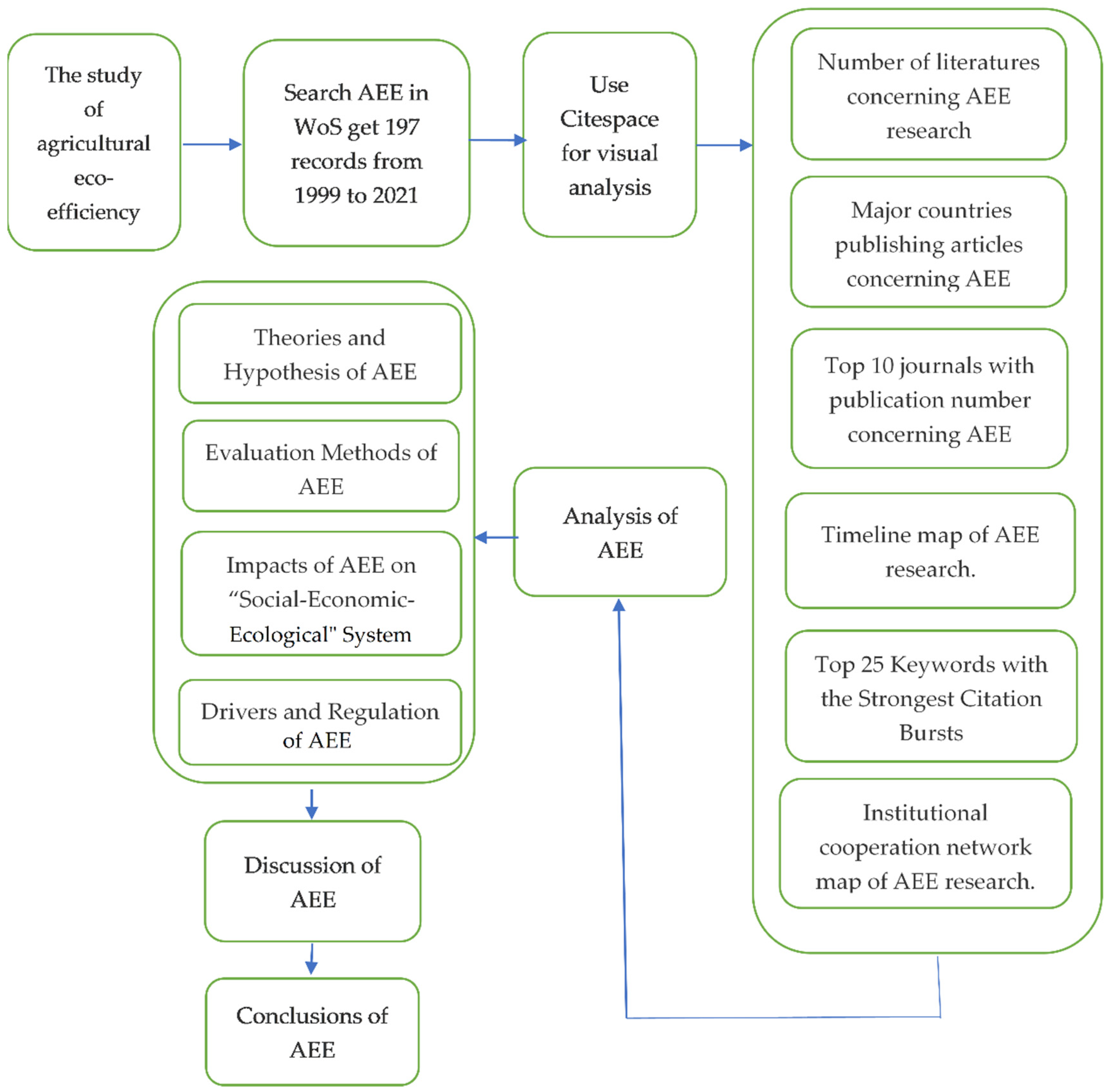
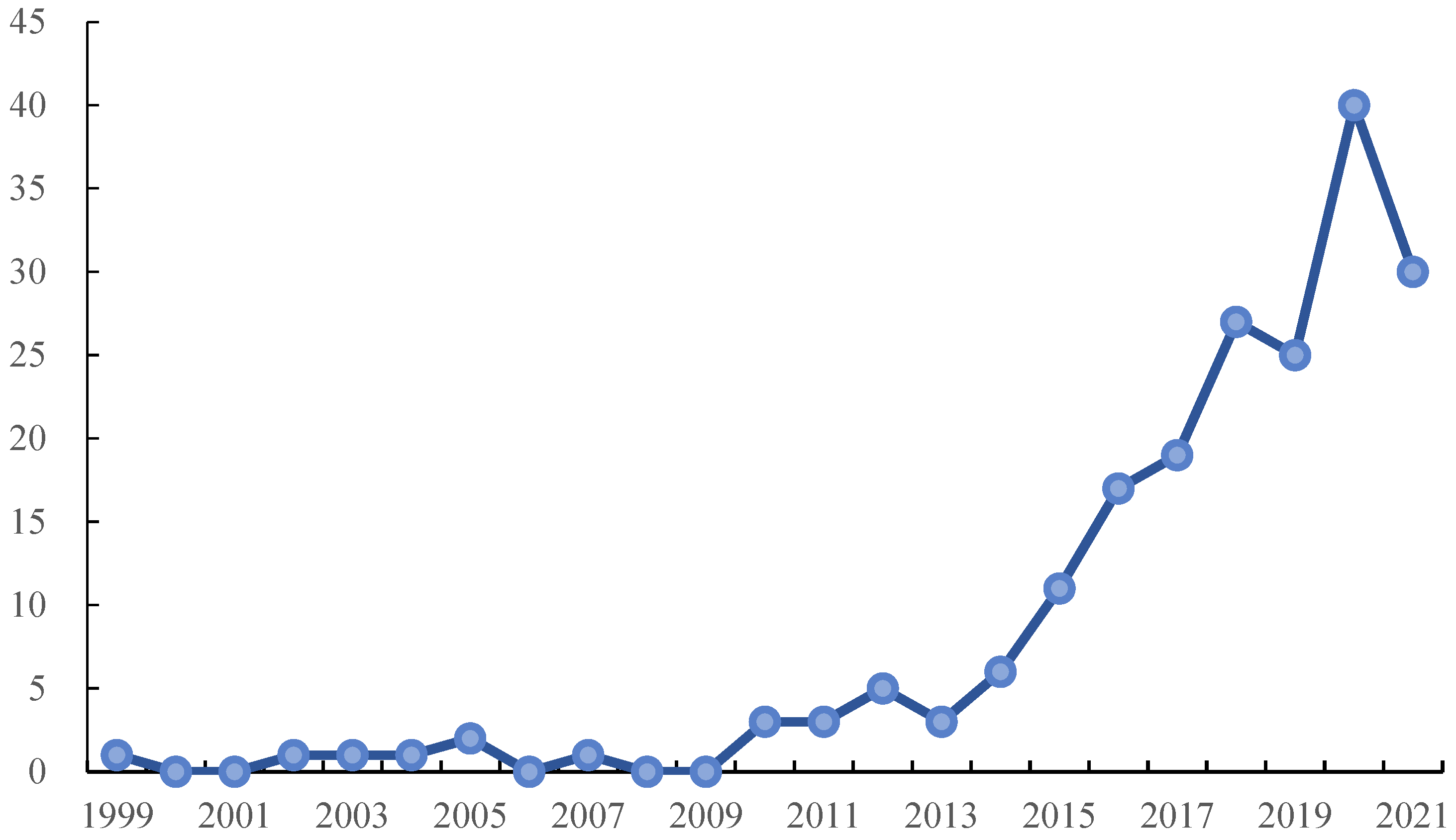
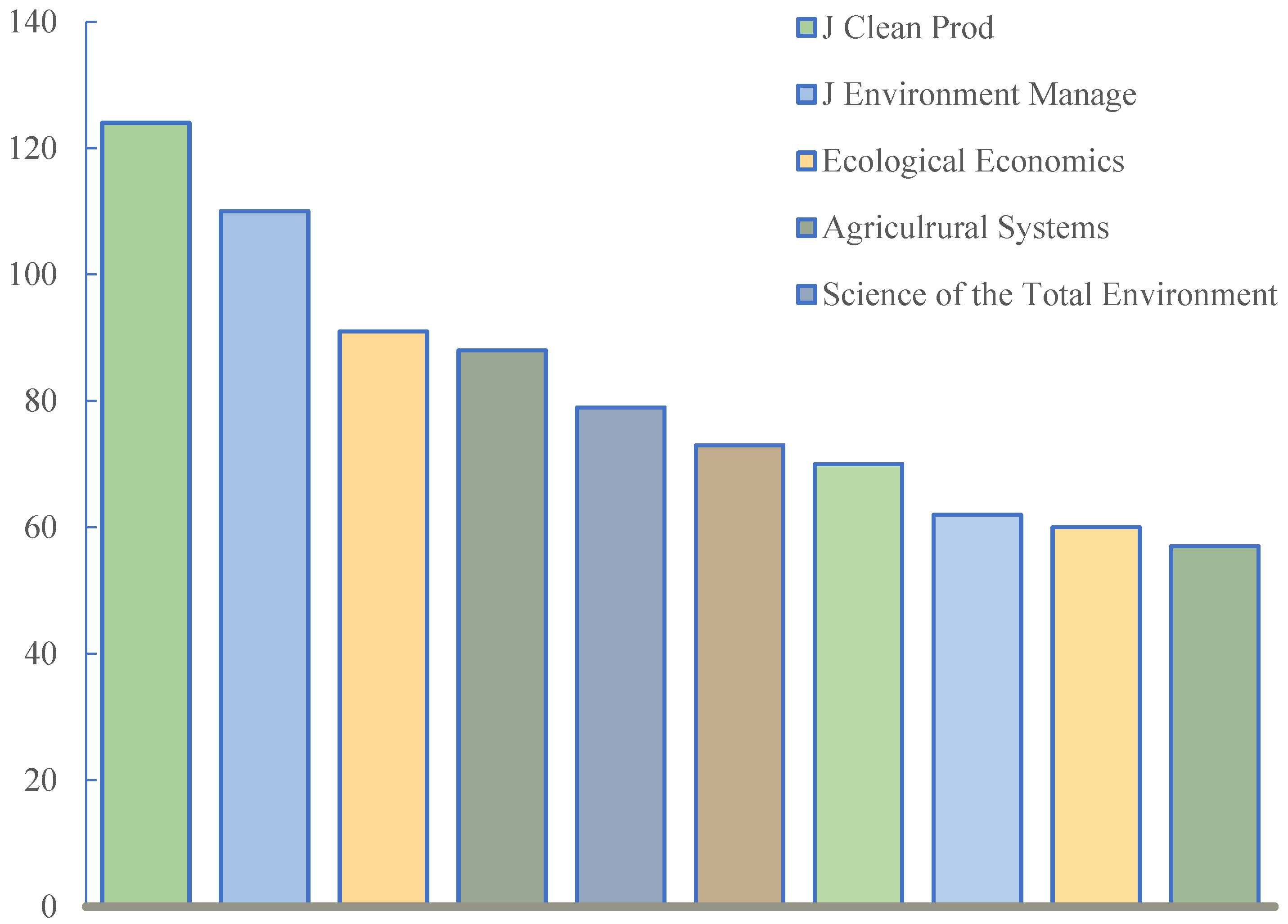
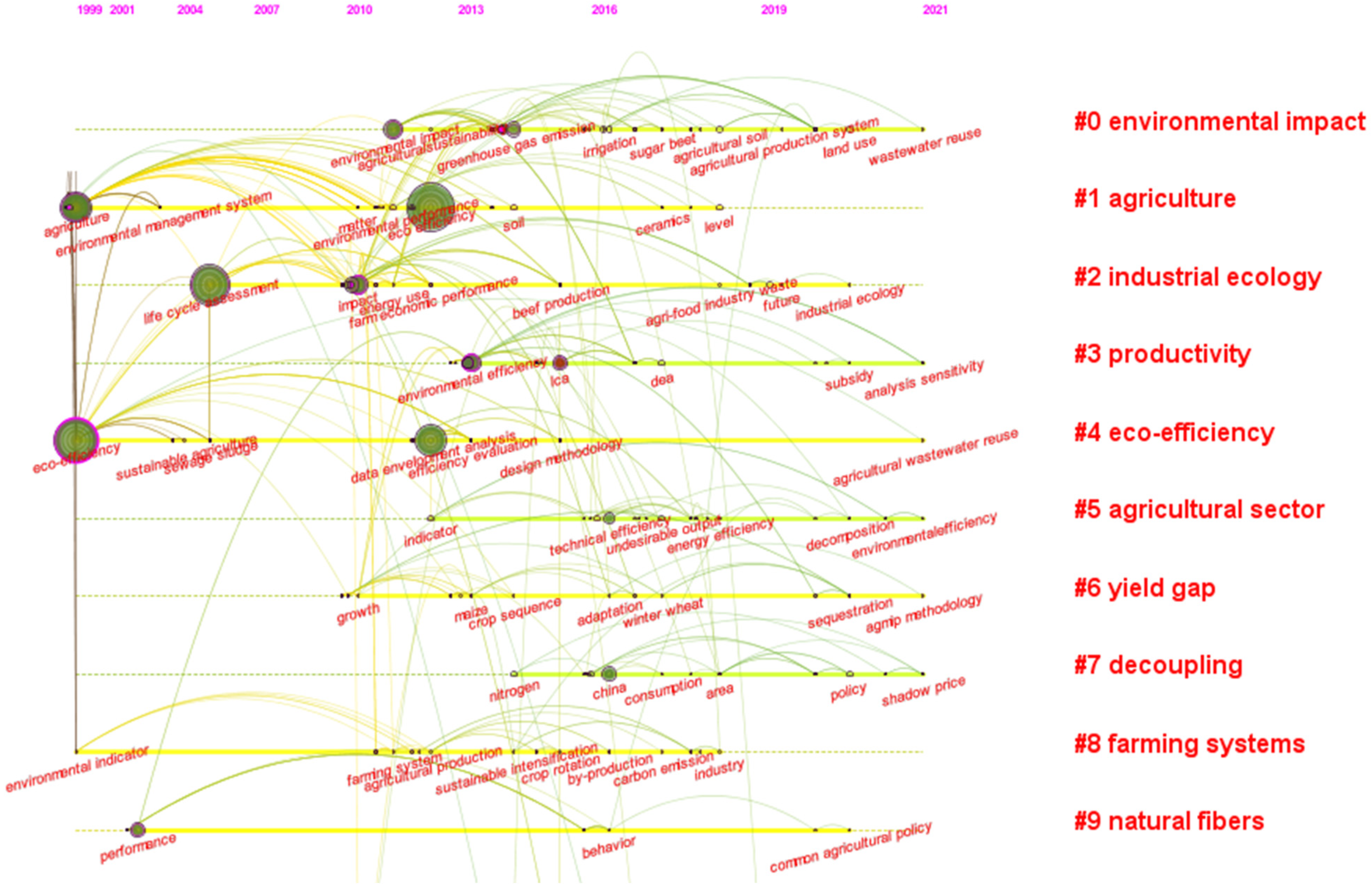
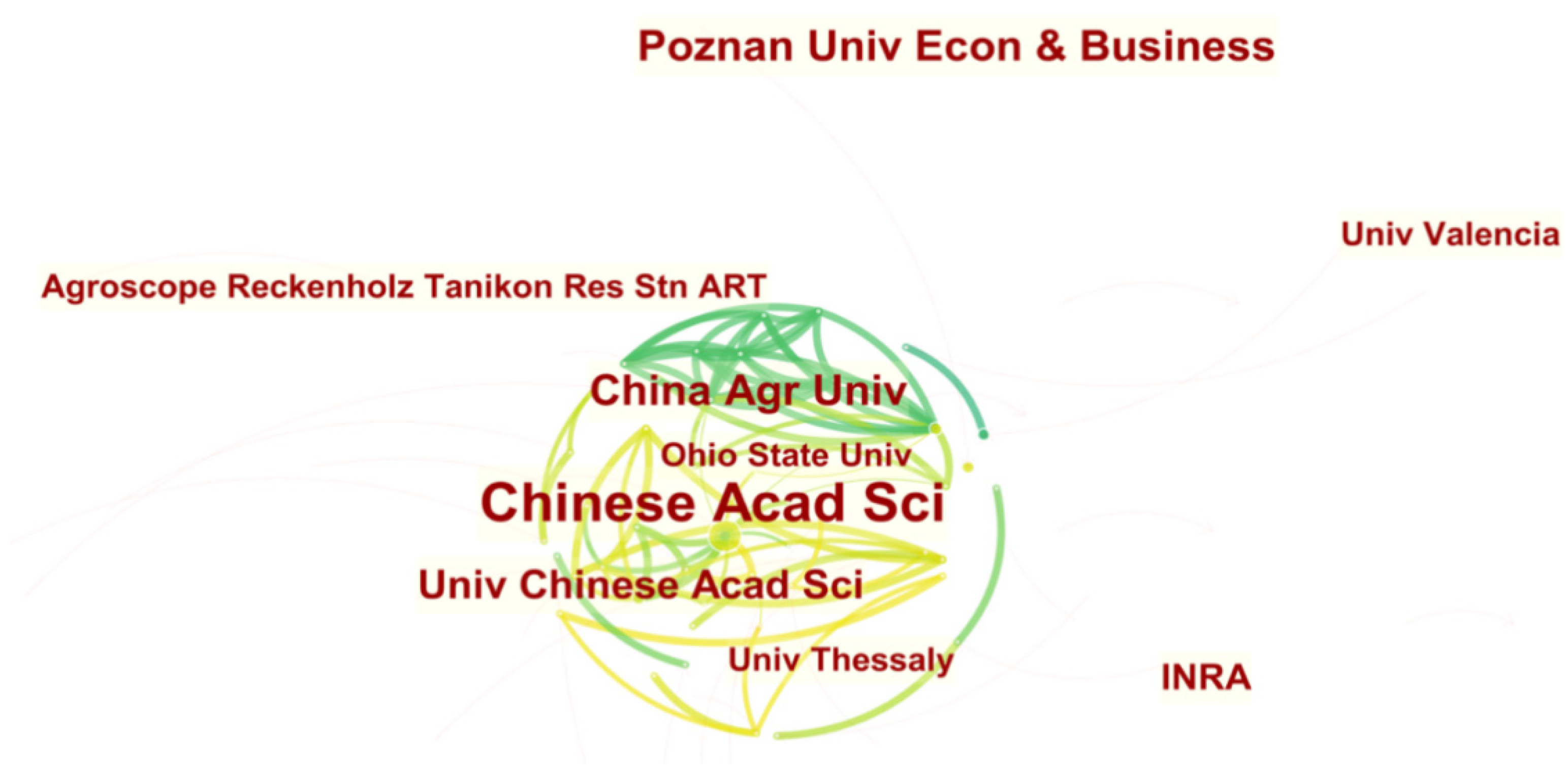
| Inclusion Criteria | Exclusion Criteria | |
|---|---|---|
| Database selection | WoS Core Collection | Not WoS Core Collection in WoS |
| Research theme | Focusing on AEE (e.g., theories and hypothesis, evaluation methods, impacts, drivers and regulation) | Irrelevant to AEE |
| Research subjects | Foreign authors | Domestic authors |
| Language | English | Non-English |
| Literature categories | Articles and review articles | Meetings, proceedings, papers, book chapters |
| Rank | Country | Number of Articles | Centrality a |
|---|---|---|---|
| 1 | China | 47 | 0.45 |
| 2 | France | 12 | 0.21 |
| 3 | USA | 22 | 0.19 |
| 4 | Germany | 13 | 0.17 |
| 5 | Greece | 7 | 0.15 |
| 6 | Italy | 18 | 0.12 |
| 7 | Australia | 8 | 0.12 |
| 8 | Sweden | 3 | 0.1 |
| 9 | Ireland | 2 | 0.1 |
| 10 | Netherlands | 6 | 0.09 |
| Keywords | Year | Strength a | Begin | End | 1999–2021 b |
|---|---|---|---|---|---|
| yield | 1999 | 1.72 | 2010 | 2013 | ▂▂▂▂▂▂▂▂▂▂▂▃▃▃▃▂▂▂▂▂▂▂▂ |
| decision support | 1999 | 1.58 | 2010 | 2014 | ▂▂▂▂▂▂▂▂▂▂▂▃▃▃▃▃▂▂▂▂▂▂▂ |
| management | 1999 | 1.02 | 2010 | 2014 | ▂▂▂▂▂▂▂▂▂▂▂▃▃▃▃▃▂▂▂▂▂▂▂ |
| energy use | 1999 | 1.69 | 2011 | 2014 | ▂▂▂▂▂▂▂▂▂▂▂▂▃▃▃▃▂▂▂▂▂▂▂ |
| firm | 1999 | 1.21 | 2011 | 2013 | ▂▂▂▂▂▂▂▂▂▂▂▂▃▃▃▂▂▂▂▂▂▂▂ |
| indicator | 1999 | 2.35 | 2012 | 2016 | ▂▂▂▂▂▂▂▂▂▂▂▂▂▃▃▃▃▃▂▂▂▂▂ |
| agricultural production | 1999 | 1.02 | 2012 | 2017 | ▂▂▂▂▂▂▂▂▂▂▂▂▂▃▃▃▃▃▃▂▂▂▂ |
| output | 1999 | 1.55 | 2013 | 2017 | ▂▂▂▂▂▂▂▂▂▂▂▂▂▂▃▃▃▃▃▂▂▂▂ |
| water | 1999 | 1.41 | 2013 | 2016 | ▂▂▂▂▂▂▂▂▂▂▂▂▂▂▃▃▃▃▂▂▂▂▂ |
| ecological intensification | 1999 | 1.24 | 2013 | 2014 | ▂▂▂▂▂▂▂▂▂▂▂▂▂▂▃▃▂▂▂▂▂▂▂ |
| maize | 1999 | 1.16 | 2013 | 2017 | ▂▂▂▂▂▂▂▂▂▂▂▂▂▂▃▃▃▃▃▂▂▂▂ |
| soil | 1999 | 2.96 | 2014 | 2015 | ▂▂▂▂▂▂▂▂▂▂▂▂▂▂▂▃▃▂▂▂▂▂▂ |
| environmental impact | 1999 | 1.32 | 2015 | 2016 | ▂▂▂▂▂▂▂▂▂▂▂▂▂▂▂▂▃▃▂▂▂▂▂ |
| crop | 1999 | 1.43 | 2016 | 2017 | ▂▂▂▂▂▂▂▂▂▂▂▂▂▂▂▂▂▃▃▂▂▂▂ |
| assessment ICA | 1999 | 1.24 | 2016 | 2017 | ▂▂▂▂▂▂▂▂▂▂▂▂▂▂▂▂▂▃▃▂▂▂▂ |
| CO2 emission | 1999 | 1.07 | 2016 | 2017 | ▂▂▂▂▂▂▂▂▂▂▂▂▂▂▂▂▂▃▃▂▂▂▂ |
| driver | 1999 | 1.05 | 2016 | 2017 | ▂▂▂▂▂▂▂▂▂▂▂▂▂▂▂▂▂▃▃▂▂▂▂ |
| DEA | 1999 | 1.84 | 2017 | 2019 | ▂▂▂▂▂▂▂▂▂▂▂▂▂▂▂▂▂▂▃▃▃▂▂ |
| cropping system | 1999 | 1.53 | 2017 | 2019 | ▂▂▂▂▂▂▂▂▂▂▂▂▂▂▂▂▂▂▃▃▃▂▂ |
| lCA | 1999 | 1.33 | 2017 | 2018 | ▂▂▂▂▂▂▂▂▂▂▂▂▂▂▂▂▂▂▃▃▂▂▂ |
| bioenergy | 1999 | 1.33 | 2018 | 2019 | ▂▂▂▂▂▂▂▂▂▂▂▂▂▂▂▂▂▂▂▃▃▂▂ |
| ecosystem service | 1999 | 2.3 | 2019 | 2021 | ▂▂▂▂▂▂▂▂▂▂▂▂▂▂▂▂▂▂▂▂▃▃▃ |
| future | 1999 | 1.53 | 2019 | 2021 | ▂▂▂▂▂▂▂▂▂▂▂▂▂▂▂▂▂▂▂▂▃▃▃ |
| intensification | 1999 | 1.21 | 2019 | 2021 | ▂▂▂▂▂▂▂▂▂▂▂▂▂▂▂▂▂▂▂▂▃▃▃ |
| food | 1999 | 1.08 | 2019 | 2021 | ▂▂▂▂▂▂▂▂▂▂▂▂▂▂▂▂▂▂▂▂▃▃▃ |
Publisher’s Note: MDPI stays neutral with regard to jurisdictional claims in published maps and institutional affiliations. |
© 2022 by the authors. Licensee MDPI, Basel, Switzerland. This article is an open access article distributed under the terms and conditions of the Creative Commons Attribution (CC BY) license (https://creativecommons.org/licenses/by/4.0/).
Share and Cite
Wang, G.; Shi, R.; Mi, L.; Hu, J. Agricultural Eco-Efficiency: Challenges and Progress. Sustainability 2022, 14, 1051. https://doi.org/10.3390/su14031051
Wang G, Shi R, Mi L, Hu J. Agricultural Eco-Efficiency: Challenges and Progress. Sustainability. 2022; 14(3):1051. https://doi.org/10.3390/su14031051
Chicago/Turabian StyleWang, Guofeng, Rui Shi, Lingchen Mi, and Jinmiao Hu. 2022. "Agricultural Eco-Efficiency: Challenges and Progress" Sustainability 14, no. 3: 1051. https://doi.org/10.3390/su14031051
APA StyleWang, G., Shi, R., Mi, L., & Hu, J. (2022). Agricultural Eco-Efficiency: Challenges and Progress. Sustainability, 14(3), 1051. https://doi.org/10.3390/su14031051







